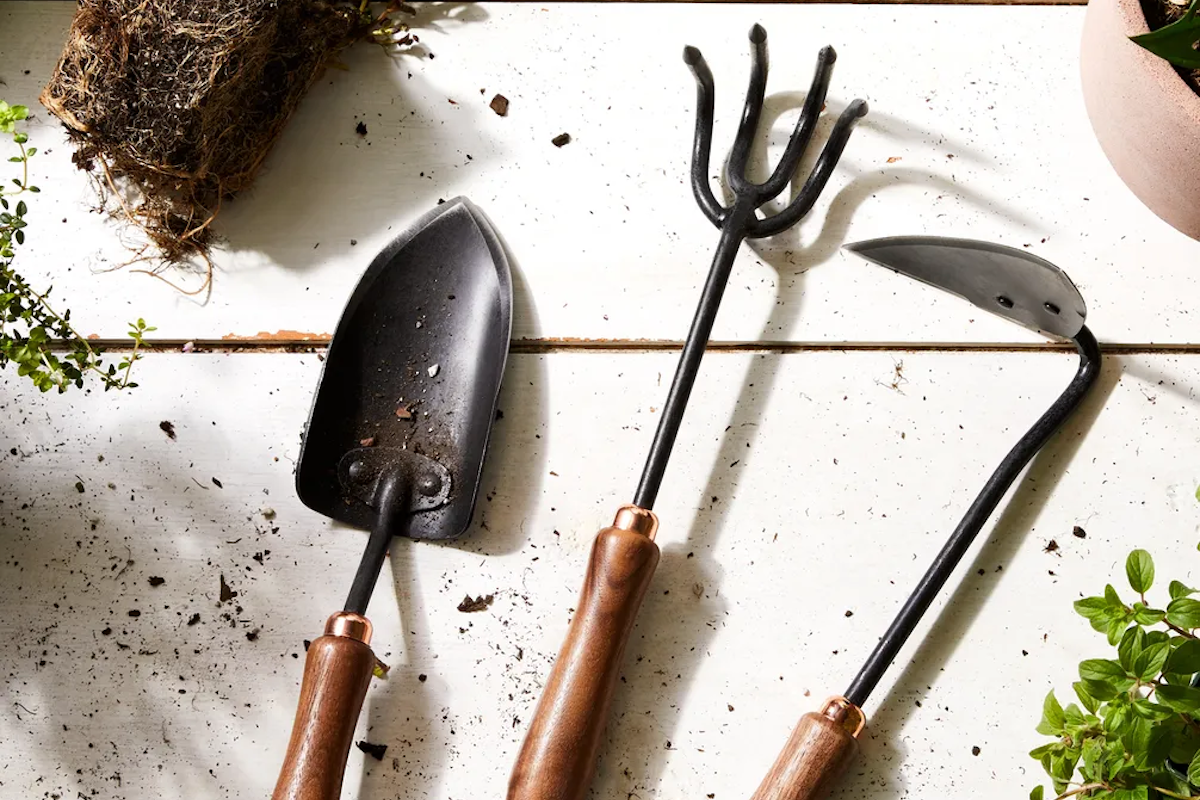Maintenance. Not a very glamorous word, is it? But, before you start running away, let me reassure you that this is going to be a totally doable part of your plant-care routine that will become as second nature as “accidentally” buying more plants than you intended to. (This is a safe zone, no judgments. I’m right there with you.)
The spring and summer months are busy ones in the plant world. It’s peak plant-growing (and accumulation, ahem) season after all! So, now is the perfect time to take care of your hardest-working tools before that green leafy distraction hits. This rings true whether you’re planning on harvesting tomatoes or simply pruning your indoor houseplants.
Yes, garden tools are the obvious workhorses in need of tending to as they get vigorous use and more exposure to the elements, but don’t think that taking care of indoor tools is not as important as those being used outside. In fact, I chatted with Danae Horst, author of “House Plants For All” and founder of Folia Collective, to get the nitty-gritty on why keeping your indoor snips in good shape is the key to growing that green thumb:
This is what she had to say: “Though it’s often overlooked, tool maintenance is just as important for indoor plants as it is for outdoor gardening. Infections especially can be spread through dirty cutting tools, so cleaning and sterilizing these tools after every use is a great prevention practice. Dull shears, snips, or other blades will mash stems rather than cut them cleanly, which can keep new growth from sprouting when pruning and can trigger rot in cuttings, making successful propagation difficult.”
Remember, when thoughts of maintenance start sounding like a real drag, the goal here is to set yourself up for success before you even plant that first seed or bring home a new plant baby. By keeping tools and grow pots clean, you’ve already taken the first step towards caring for the healthiest plants possible. Ready to roll up your sleeves? Here are a few quick cleaning tips that I personally practice and that I hope will get you going:
Buff up shears and harvest knives
We’re all guilty of running our tools a little ragged, often stuffing them away after a snip here or there without a proper wipe-down. While this isn’t a huge problem when done once in a blue moon, storing wet or dirty shears and knives over time will start taking its toll…mostly in the name of rust. Arm yourself with a rust eraser pad and a quality Camellia Oil made for cutlery, and together with a little elbow grease, you’ll be bringing your tarnished blades back to life and looking good as new. Trust me, I’ve brought back a harvesting knife that looked like an old corroded car part. Pure magic!
Sanitize pruning tools
We don’t often think about what we can’t see and there are times when pathogens (those nasty bacteria, virus, or other microorganisms that can cause disease) are transferred between plants with a simple shared snip of your shears. It’s important to sterilize your cutting tools when removing deceased leaves and branches. To avoid any accidental contamination, make a habit of cleaning tools when working between plants. I like to put a simple disinfectant into a small amber glass spray bottle that tucks easily into my apron pocket or garden bag so it’s always on hand. Simply spray 70-100% isopropyl alcohol directly onto your shears and wipe clean between cuts to minimize the spread of any bad guys.
Clean seed trays and grow pots
It’s easy to disregard pots once you’re no longer using them, but previously used growing containers can harbor fungal and bacterial diseases that could prevent proper germination; potentially kill new seedlings; and even wreak havoc on transplanted starts or houseplants. Speaking of houseplants, don’t forget to check in on those drip trays which could house more than just fungus. Stagnant water loves you-know-who (I’m looking at you mosquitos), especially in the summertime. To disinfect and deep-clean containers between seed-starting seasons or plant repotting, simply use soap and water to remove dirt, then dip in a solution of one-part non-chlorine bleach to nine-parts water. You can also make a sanitizing solution with equal parts water and white vinegar if you’d like to keep your bleach away from your home-grown edibles. Both work wonders!
Stay on top of it
Scheduling out time or making seasonal notes to take care of your tools might sound like a bore, but it is the easiest way to care of things before they catch up with you. You might not want to do a full buff-up of your shears after every harvest, but you should put in a little TLC after a heavy-lifting period (think: in fall after your busy summer-growing spree). Similarly, making simple weekly habits like wiping down or sanitizing your tools will keep everything cleaner in the long run, and avoiding any heavy scrubbing or additional maintenance later.
I like to keep a simple mental checklist that I can run through each weekend, which keeps me on task and not feeling overwhelmed. Basic weekend actions like winding up the hose, making sure tools are hosed off and stored properly in my garden bag, or cleaning out and stacking grow pots that are no longer in use will become as routine as other weekly chores and keep you growing without setbacks.
This post contains products independently chosen (and loved) by Food52 editors and writers. Food52 earns an affiliate commission on qualifying purchases of the products we link to.


